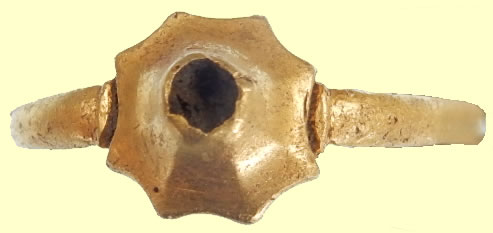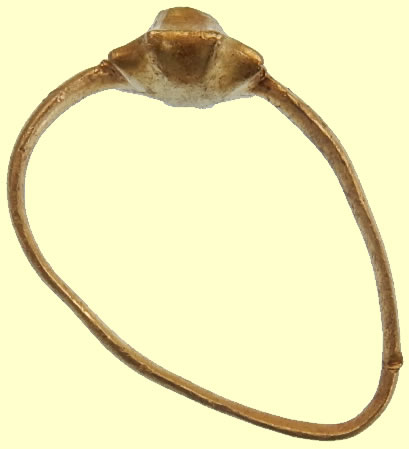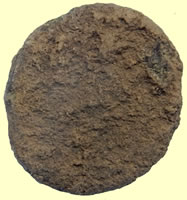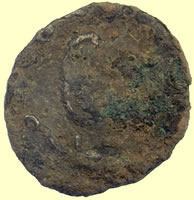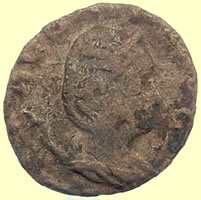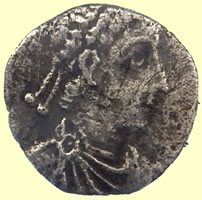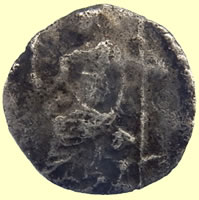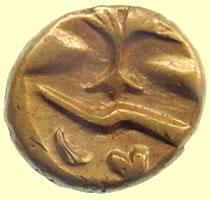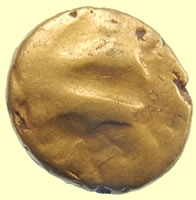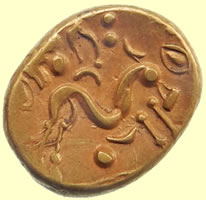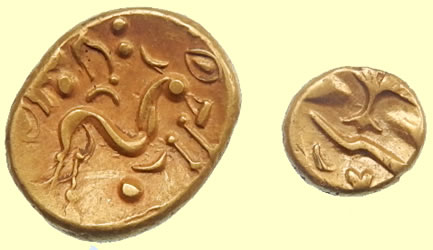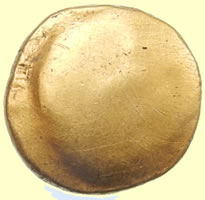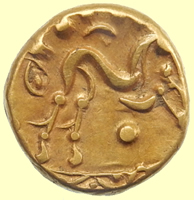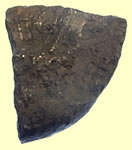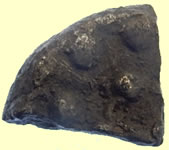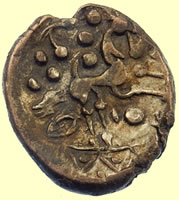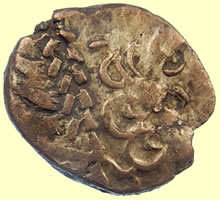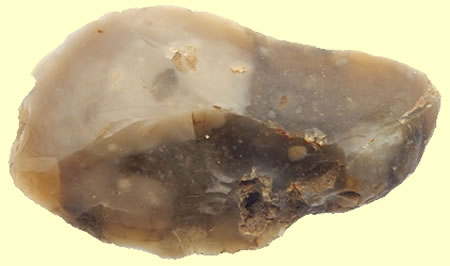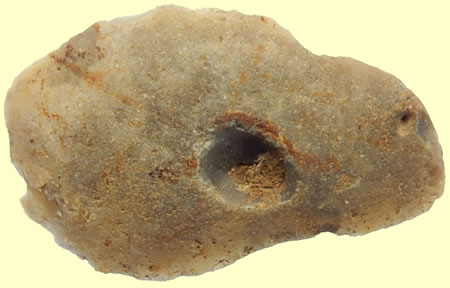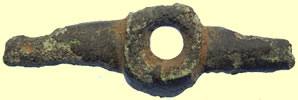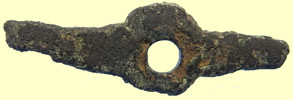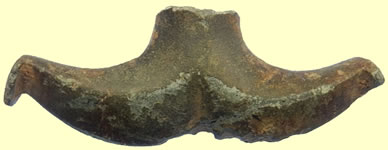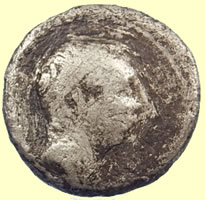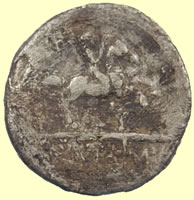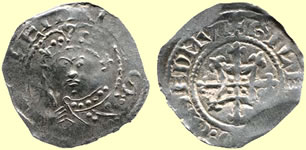

Metal detecting holidays in England with the World's most successful metal detecting club.
Twinned with Midwest Historical Research Society USA
| 2015 Feb finds page |
|
|||
13thC Medieval gold ring - reported as treasure to museum 24mm, 2.0g |
|||
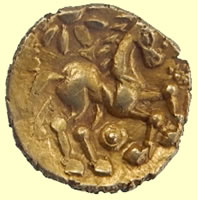  |
|||
Probably a 40 BC Southern style QC type or even a Regini - it is in between the two, classed as rare Sent to PAS for recording 12.1mm,1.36g “Maldon Wheel” type. |
|||
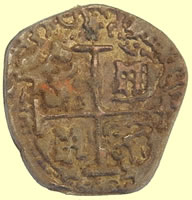 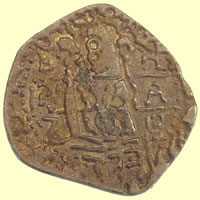 |
|||
Fascinating gilded coin find - fake 1709 gold 2 Escudos 5.09g, 24.1mm Id'd by club researcher Ohio Drew Obverse: cross potent with quartered castles and lions. Border of dots. The legend reads PHILILLUP V D G HISPAN. |
|||
|
|||
2ndC Roman silver coin - needs a good 'cook' to remove crust Just a quick word - I'll need more time to tell you about the reverse (and figure it out) but this is an antoninianus of Salonina, the wife of Gallienus, 253-268. This was the period in which the Empire really went off the rails and it was only by the skin of their teeth that Gallienus next two successors managed to pull things back together enough for the Empire not to fragment and dissolve right then. Mark About all I can tell you on the reverse of the Salonina is that it appears to be a personification standing and holding a cornucopiae. The orientation of your photo of the reverse appears to be at around 1:00-1:30. There are either hints of lettering around 10:00 in your photo which make me think it might be "CONCORDIA", but they might just be coincidental spots and stains which appear possible to be letters at this point. If the reverse of this gets any cleaner, I can probably tell you more about it.
|
|||
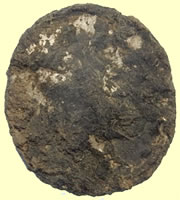 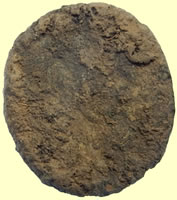 |
|||
| 2ndC Roman silver coin - needs a good 'cook' to remove crust | |||
  |
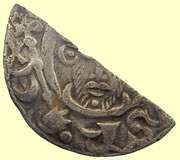  |
||
1634 Charles 1st hammered copper rose farthing |
1199-1216 John hammered silver short cross half penny - Class 5b2 Obv HENRIC REX Rev AN.M. ON - Moneyer IOhAN M of Canterbury |
||
 |
 |
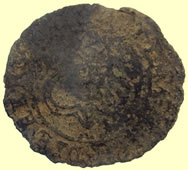 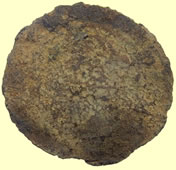 |
|
1800 - 1818 Royal Packet Navy button Mail ships |
1904 - 1929 Colchester Corporation tramways button | 1586 Hans Krauwincel II Rose orb Jeton | |
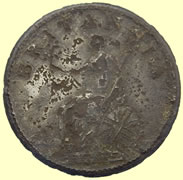 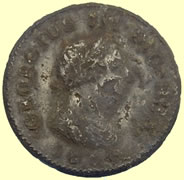 |
|||
| Very rare 1806 George III bullhead silver proof farthing - not sure if this is a period forgery | |||
 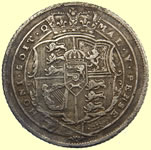 |
  |
||
| 1817 George III milled silver sixpence | Medieval decorated lead spindle whorl | ||
 |
  |
||
| Baaaaaaaaaaa | A copper alloy duit of Hollandia province in the Netherlands, issued under Jacob Janszn de Jonge, 1590-1599 AD Dutch virgin sitting in a garden with closed fence and her right arm raised, .AUX.NOS(T).IN.NOM.DOM(INI |
||
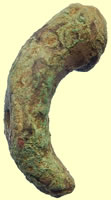   |
|||
| 2ndC Roman trumpet brooch | |||
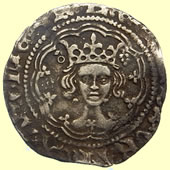  |
|||
Rarer 1420 Henry V hammered silver half groat - Class F London, annulet and trefoil by crown Satire stop to other legend - 11 arches to tressure - mullet on breast- tall neck with 'larynx'- Crown of earlier class A-C Obv +hENRIC:DI:GRA:REX.ANGLIE:Z:F' Rev CIVI/TAS/LOND/DON - London mint |
|||
  |
  |
||
| 1940's silver St Christopher pendant | 1939 George VI milled silver sixpence | ||
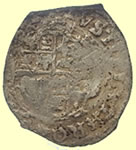 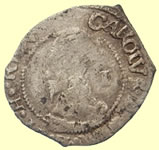 |
 |
 |
|
| 1624 Charles 1st hammered silver penny | 18thC Royal Navy button | Georgian watch winder | |
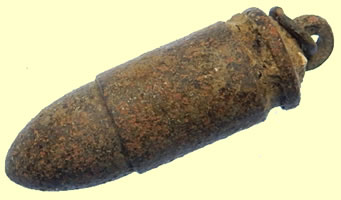 |
 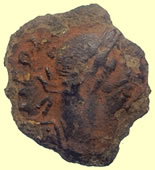 |
||
| WWI Trench art bullet pendant | 4thC Roman bronze | ||
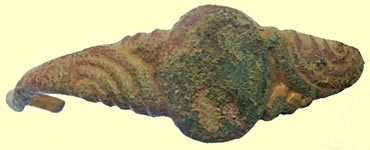 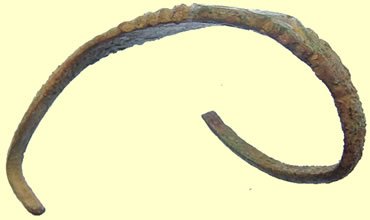 |
|||
| Georgian signet ring | |||
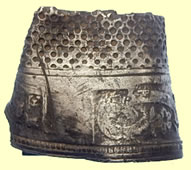 |
  |
||
| Georgian silver thimble | Unknown early widget | ||
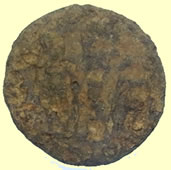  |
  |
||
| Mid 4thC Roman bronze - Constantine two soldiers standing | 1845 Victoria milled silver sixpence | ||
Roman silver coin - Honorius - 393-423 AD. 0.41g, 11mm The coins are a denomination known as a siliqua. Some of them had been clipped to remove silver from the edges. Such tampering with the coinage was a very serious offence, and could only have taken place on the scale it is found in Britain when the Roman hold on the province had relaxed early in the fifth century AD. Clipping was done to create a pool of silver bullion from the currency of the state that could be used by private individuals for their own ends: treason, in a word. Conventional wisdom has it that the clipping of coins was actually done to mint more unofficial siliquae and so make the pool of currency stretch a bit further at a time when no more bona fide Roman coinage was reaching the province. |
|||
  |
 |
 |
|
1216 Henry III hammered silver short cross half penny Rev VND - London mint |
18thC crotal bell | Georgian shoe buckle | |
  |
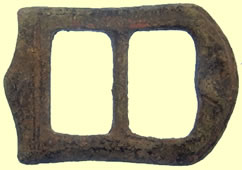 |
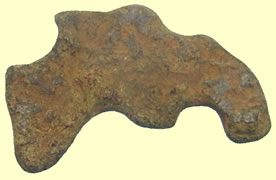 |
|
| Very unusual 16thC Tudor lead clothing fastener | A complete cast copper alloy buckle of post-medieval date. The buckle is a double loop asymmetrical shape Circa 1575- 1700 |
C10thC Saxon stirrup mount fragment | |
  |
|||
| Medieval gilded hooked bar mount | |||
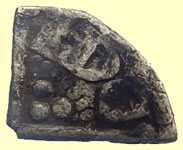 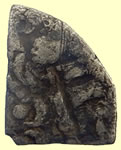 |
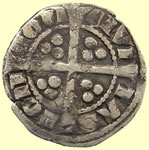 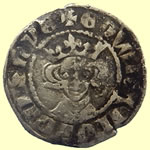 |
||
1247 Henry III hammered silver voided long cross farthing Rev NDE - London mint |
1299-1300 -Edward 1st hammered silver penny - Class 9 star on breast Obv EDWR ANGL DNS HYB Rev CIVI/TAS/LON/DON - London mint |
||
  |
 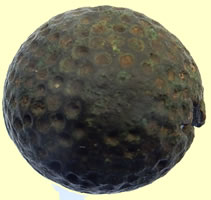 |
||
1340 Edward III hammered silver penny - Class 15d Rev EDWAR ANGL DNS HYB Rev SCIE/DNV/NDI/VIL - Bury St Edmunds mint |
Medieval beehive thimble | ||
 |
  |
||
| 18thC clog fastener | 1755 George II milled copper half penny | ||
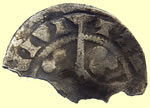 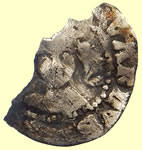 |
 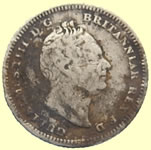 |
||
1279 -Edward 1st hammered silver penny - Obv DWARVS R***** |
1837 William IV milled silver four pence | ||
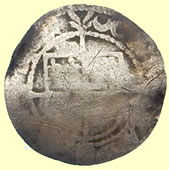 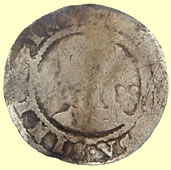 |
 |
||
1587 - 1589 Elizabeth 1st hammered silver half groat - crescent mint mark |
Georgian belt slide | ||
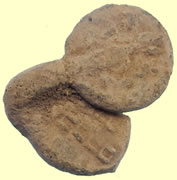 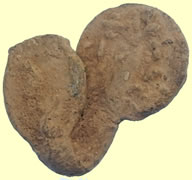 |
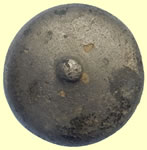  |
||
| Complete post medieval lead alnage cloth seal | 17thC nipple button | ||
 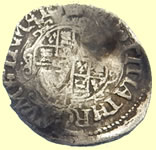 |
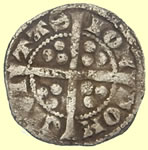 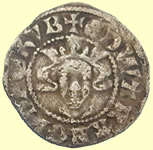 |
||
| 1635- 6Charles 1st hammered silver half groat - | 1300-1310 Edward 1st hammered silver penny Cross Pattee- Class 10cf4 Obv EDWAR ANGL DNS HYB Rev CIVI/TAS/LON/DON - London mint |
||
 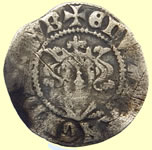 |
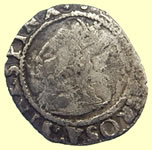 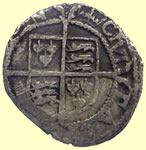 |
||
1300-1310 Edward 1st hammered silver penny - Cross Pattee - Class 10cf3 Obv EDWAR ANGL DNS HYB Rev CIVI/TAS/CAN/TOR - Canterbury mint |
1567- 70 Elizabeth 1st hammered silver penny - Coronet mint mark | ||
  |
|||
| 17thC decorated finger ring | |||
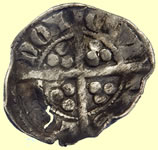  |
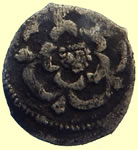 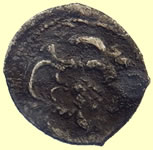 |
||
1279 Edward 1st hammered silver penny Cross Pattee Obv EDWAR ANGL DNS HYB Rev CIVI/TAS/LON/DON - London mint |
Probably one of the smallest hammered silver coins you can find, 1/3rd the weight of a Medieval silver farthing 1625-42 Charles 1st hammered silver half penny - Rose each side - no legend type
0.17g, 9.5mm |
||
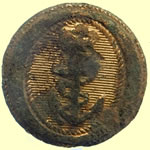 |
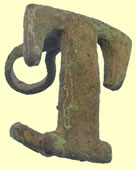 |
 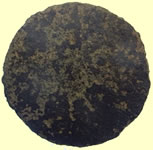 |
|
| RN Capt / Commander - 1812 RN Lieutenant - 1812 RN Midshipman - 1812 |
WWII Army lapel badge - could be Terretorial Army | 17thC hammered copper trade farthing | |
 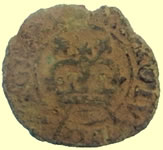 |
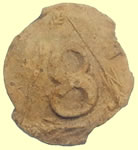 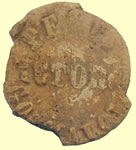 |
||
| 1634 Charles 1st hammered copper rose farthing | Post medeival lead bale seal | ||
 |
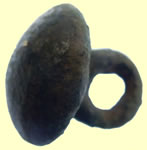 |
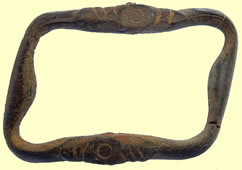 |
|
| 18thC Royal Navy button | 16thC Tudor button | Georgian buckle | |
  |
 |
 |
|
1247 Henry III hammered silver voided longcross half penny Rev GLO/VCE - Gloucester mint |
Georgian watch winder | Post Medieval cast copper alloy single loop buckle frame. 1500-1650 AD |
|
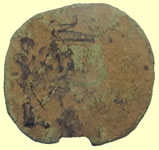 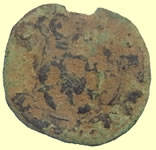 |
|||
| 1634 Charles 1st hammered copper rose farthing | |||
70BC Morini Celtic gold qtr - sent to PAS for recording 1.51g, 10.5mm |
|||
50 BC Gallo Belgic Celtic gold full stater- sent to PAS for recording 6.18g, 17.2mm |
|||
Both coins found by Mass Steve so I did this size comparison photo of a full and qtr stater |
|||
50 BC Gallo Belgic Celtic gold full stater- sent to PAS for recording 6.30g,17.7g |
|||
50 BC late British G 'Early Clacton' debased gold stater fragment - sent to PAS for recording 0.55g, 9.9mm |
|||
50 BC late British G 'Early Clacton' gold stater - sent to PAS for recording 20mm, 5.73g |
|||
 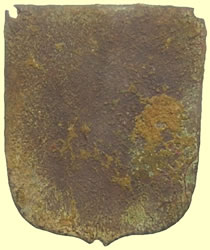 |
|||
| Stunning large enamelled medieval heraldic shield mount - 40mm high | |||
 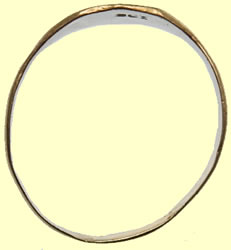 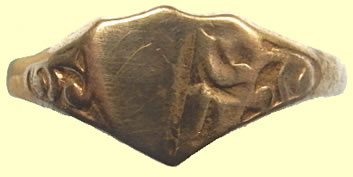 |
|||
| Victorian gold signet ring - Continental mark | |||
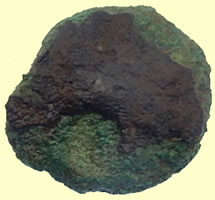 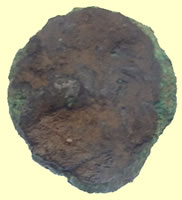 |
|||
1st Celtic bronze unit - needs careful soaking and cleaning Obv Horse facing right |
|||
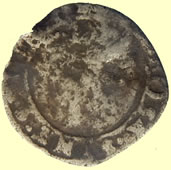 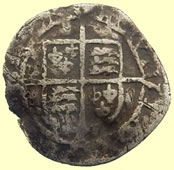 |
 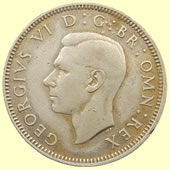 |
||
| 1569-71 Elizabeth 1st hammered silver half groat- Castle mint mark | |||
 |
 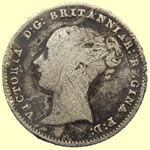 |
||
| 20thC Robertson's Golly Badge Bagpiper, blue Golden Shred waistcoat, type II, impressed HW MILLER, eyes down, blue hands, red feet, metal between legs, Golden Shred on yellow bagpipes, mouth pipe to left | 1843 Victoria milled silver four pence | ||
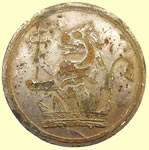 |
 |
 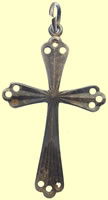 |
|
| 19thC livery button | 1902 Royal Navy Hospitals | Victorian silver cross | |
 |
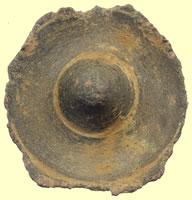  |
||
Unknown trade weight - Averdepois mark under I - London 1590-1826 Obv V I D - 6 pennyweights ? |
Roman mount ? | ||
|
|||
| 11,000 BC Stone Age flint scraper | |||
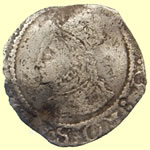  |
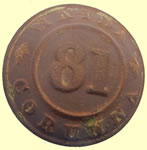 |
||
| 16thC Elizabeth 1st hammered silver penny | 1812 - 81st Loyal Lincoln Regiment (Maida Corunna) In 1807 the Honour "MAIDA" was added above the circle, and in 1812 the Honour "CORUNNA" was given to the regiment |
||
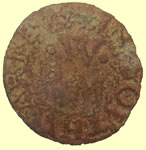  |
  |
||
| 1652 John Vanewall of Harwich Essex , (W/IM) hammered copper trade farthing | 2ndC Roman fibular brooch | ||
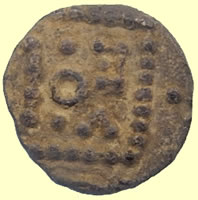 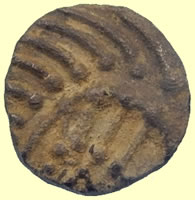 |
|||
Primary Saxon silver sceat 600- 700 AD - Plumed Bird variety - Sent to Fitzwilliam musuem for recording and confirmed type 1.19g, 12.1mm Many thanks for this new coin, which I have recorded as EMC 2015.0044. This is a classic example of Series E, Vico variety 2. |
|||
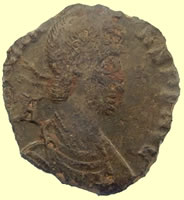 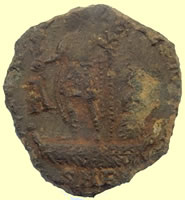 |
|||
Amazing condition Roman bronze coin sent to Mark Lehman for ID 2.90g, 21.5mm This bronze is a pretty unusual - and fairly scarce - variety of a usually quite common type: the FEL TEMP REPARATIO, but instead of the anticipated soldier spearing the unfortunate horseman, this Fel Temp has the emperor holding a small figure of Victory on a globe and a labarum while standing in the prow of a ship sailing left, steered by Victory. The SAR mint mark in the exergue and the A's in the fields place its origin in the 2nd officina of the mint of Arles, and as RIC VIII 128. Although rated "C2" (very common) for frequency in RIC, in my experience this is quite scarce and you're likely to see hundreds of other FEL TEMP Æ2's for every one of this Constans / Gallery-Victory type Majorina you encounter. Mark
|
|||
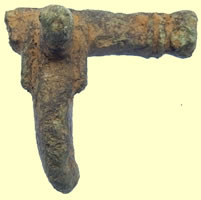  |
 |
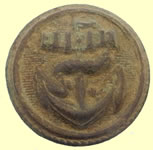 |
|
| 3rdC Roman cross bow brooch | Ppinner piece for the game of 'Put & Take' | 1900 Generic merchant seaman button | |
 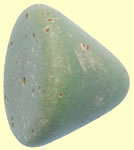 |
 |
||
| Interesting jade counter | Roman lead stylis | ||
 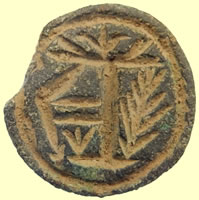 |
|||
| 13thC medieval seal matrix | |||
|
|||
Roman lock bolt of bronze, circa 100 AD - 200 AD Lock bolts formed part of a tumbler lock and would have been opened with a slide key. Compare WAW-73CEE6 and BERK-D5E561 which state that "Similar lock bolts were discovered at Vindolanda in contexts dating between AD 120 and 180 (Birley, 1997, p26)." |
|||
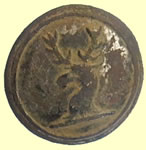 |
 |
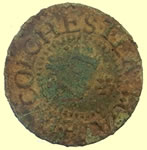 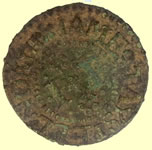 |
|
| 19thC livery button | 19thC livery button | 1668 James Tayspill of Colchester hammered copper trade farthing Norweb |
|
 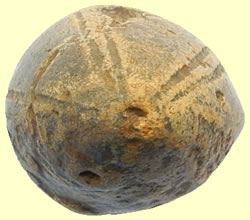  |
|||
An internal flint mould of an echinoid (Echinocorys) Echinoderms first appeared in the fossil record in the Cambrian around 530 million years ago |
|||
  |
 |
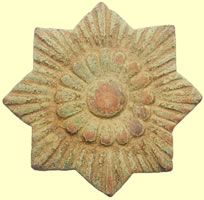 |
|
| 1500=1700 hooked mount | Georgian watch winder | Georgian mount | |
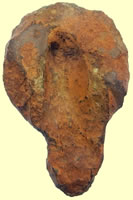 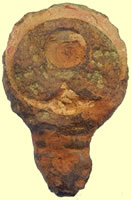 |
|||
| Roman enamelled brooch- white and red enamel remains - black star decoration | |||
 |
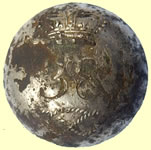 |
  |
|
Taco'd 5th Dragoons guards button Officer - 1855-1901 |
38th Regiment of Foot ( 1st Staffordshire ) Officer - 1855-1881 |
2ndC Roman fibular brooch | |
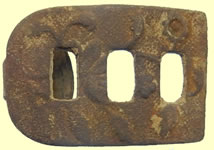 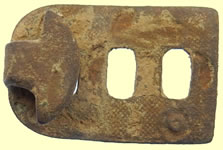 |
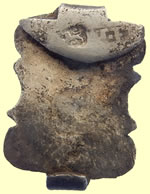 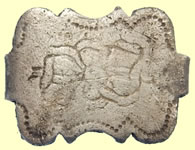 |
||
| 18thC clog fastener | 18thC silver clog fastener | ||
 |
|
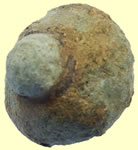 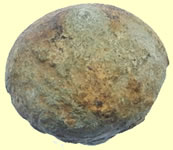 |
|
| 16thC Tudor seal spoon handle | Medieval ear wax scraper | Roman mount | |
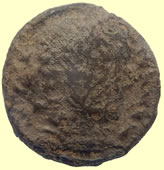 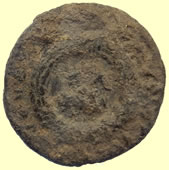 |
|||
4thC Roman bronze coin sent to Mark Lehman for ID Although it is highly likely that it is Constantine I, I can't be absolutely certain that your coin is Constantine I (it could be Licinius I, but this reverse would far rarer if the coin were for Licinius - so, that's highly unlikely). In general the details are so badly obscured that i am not able to "guarantee" any more details about it than I quote below. The best I can probably do at this point is give you a photo of what this coin would/should have looked like when new - and I happen to have one that even retains the silvering on the reverse - all these 3rd century "Æ's" were intended to be part of the "silver" series of coins and were silvered when they were minted: http://www.stoa.org/gallery/album164/A_02_ConstantineVota I can make out just enough of the legend on the reverse of yours to see that it says: "...CONST...". Although these wreath-votas were struck in the names of all the members of the family of Constantine (of that time) and both of the Licinii, the ones for the Caesars would have had CAESARVM NOSTRORVM rather than D N CONSTANTINI MAX AVG for the legend around the outside of the wreath. Although both Licinius and Constantine had coins naming the other Augustus in the reverse legend, Constantine's with his own name are by far the most common. Of course, I can't tell you which mint produced your coin, either. The exergue - which is located between about 5:00-6:00 on the reverse in your photo - is so obliterated that I doubt it will ever be possible to be sure about the mint-city. Perhaps with some additional cleaning it would be possible to positively identify it as Constantine, figure out whether it's "VOT / X, / XX, or / XXX" within the wreath, and determine the mint of origin. Mark
|
|||
  |
|||
| Medieval strap end - knopped end | |||
 |
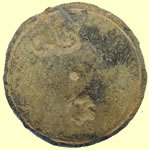 |
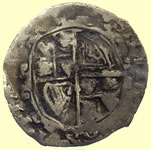 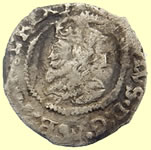 |
|
| The Great Eastern Railway button | Georgian tarde weight - Crown G cipher | 1625 Charles 1st hammered silver penny | |
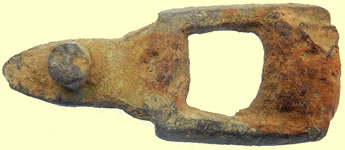 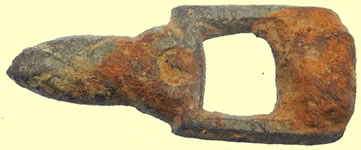 |
|||
| 13th to 14thC Medieval buckle with integral buckle plate - cross hatch decoration | |||
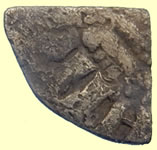 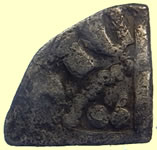 |
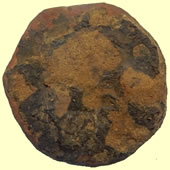 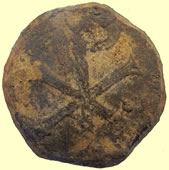 |
||
| 1247 Henry III hammered silver voided long cross farthing | The large Christogram reverse is typically associated with Magnentius & Decentius, although it is also known for Constantius II. I'm pretty sure this is one of the pair of brothers (probably Magnentius as his coins are a lot more common then Decentius') - they're always portrayed with no headgear and rather silly-looking "mullet" hairdos. I can't give you a mint on this one - it's not clean enough - and I suspect the exergue is off flan due to being off-center "to the South" a bit. Their time frame was 350-353 AD. and all their coins were from Western mints - they were not recognized in the East.
Mark |
||
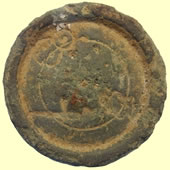 |
 |
 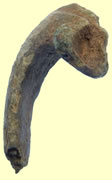 |
|
| Georgian trade weight - Crown G London cipher | 19thC titled family livery button | 2ndC Roman fibular brooch | |
 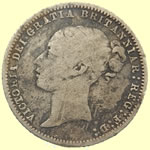 |
  |
||
| 1874 Victoria milled silver sixpence | 1247 Henry III hammered silver voided long cross half penny Obv ONB/RVS - Bristol mint
|
||
 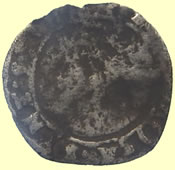 |
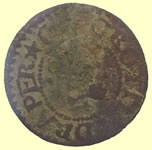 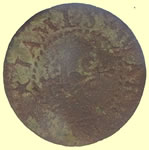 |
||
1569 - 1571 Elizabeth 1st hammered silver half groat - Castle mint mark |
Unknown 17thC James War** hammered copper trade farthing Trade Grocer, Draper not recorded Obv Crown above Fleu de Lis |
||
 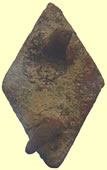 |
 |
 |
|
| 1500-1700 mount | Georgian button with glass stone | Georgian watch winder | |
  |
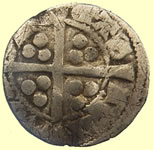 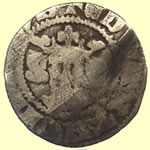 |
||
| 1216 Henry III hammered silver short cross half penny | 1279 -Edward 1st hammered silver penny Obv EDWAR ANGL DNS HYB Rev CIVI/TAS/LON/DON - London mint |
||
  |
|||
| Roman hanging pendant - circle designs | |||
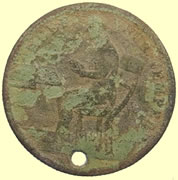 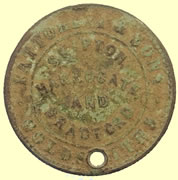 |
  |
||
19thC Ratton and Sons Harrogate token 'Your emporium' |
1877 Victoria milled silver sixpence | ||
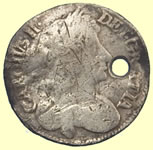  |
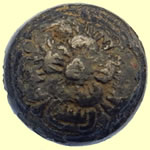 |
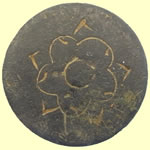 |
|
| 1679 Charles II milled silver four pence | 18thC Royal navy button | 18thC Royal navy button | |
|
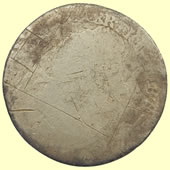  |
||
| Roman mount | George Ist 1723 milled silver shilling - issued by South Sea Company | ||
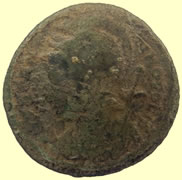 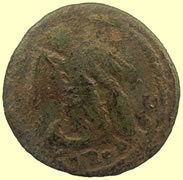 |
|||
| Roman copper ?? Sent to Mark Lehman for his views | |||
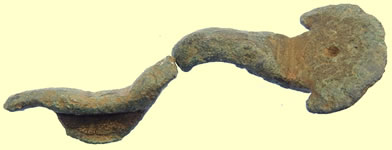  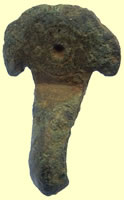 |
|||
| 2ndC Roman knee brooch | |||
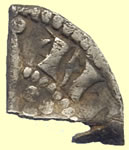 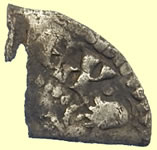 |
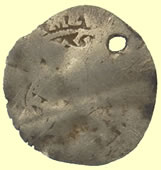 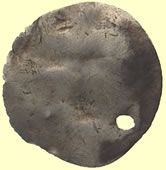 |
||
| 1247 Henry III hammered silver voided long cross farthing | 16thC Elizabeth 1st hammered silver half groat | ||
 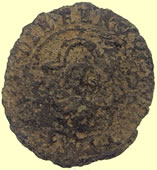 |
 |
 |
|
1586 Hans Krauwincel II Rose orb Jetton HANNS KRAVWINCKEL IN NVRENB |
Georgian watch winder | George V Royal Engineer button | |
 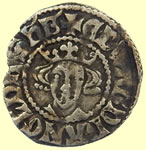 |
 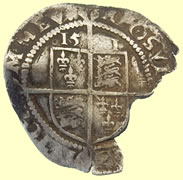 |
||
1300-1310 Edward 1st hammered silver penny - Class 10ab Obv EDWARD R ANGL DNS HYB Rev VILL/NOVI/CAS/TRI - Newcastle mint |
1571 Elizabeth 1st hammered silver sixpence - Castle mint mark | ||
 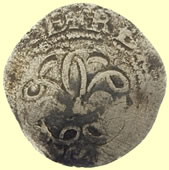 |
 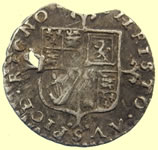 |
||
15thC Spanish hammered silver coin 1474 -1504 Seville, Spain, 1/2 real, Ferdinand-Isabel, |
1663 Charles II milled silver penny - 2nd issue- bust to edge of coin (machine made single arched crown) | ||
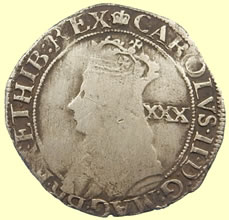 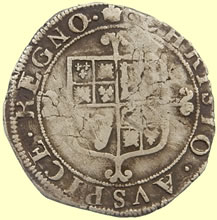 |
|||
1660-2 Charles II hammered silver half crown - 30 pence Crown mint mark - 3rd issue 14.68g, 35.1mm dia x 2mm thick |
|||
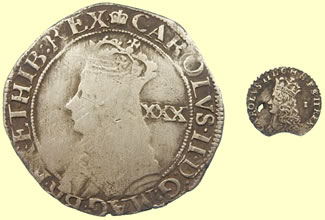 |
|||
| Size comparison of two earliest Charles II silver coins, half crown and penny | |||
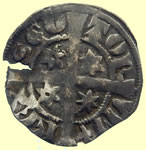 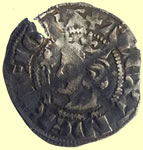 |
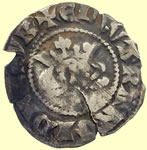  |
||
1280 1286 Alexander III Scottish hammered silver penny - 2nd Coinage Stars have 6 points Ref SA3HD-005 Obv ALEXANDER DEI GRA Rev SCO/TOR/VM+/REX
|
1279 Edward 1st hammered silver penny Obv + EDWAR ANGL DNS HYB Rev CIVI/TAS/LON/DON - London mint |
||
  |
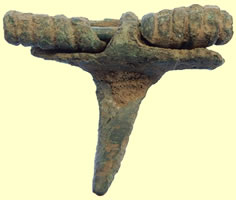 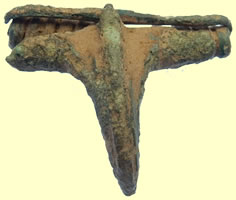 |
||
| 1604 James 1st hammered silver half groat | 2ndC Roman fibular brooch | ||
  |
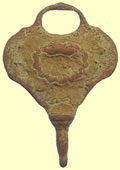 |
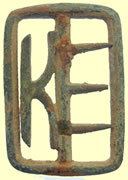 |
|
| 2ndC Roman fibular brooch | Georgian watch winder | Georgian buckle | |
  |
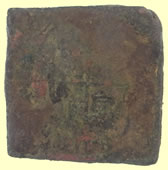 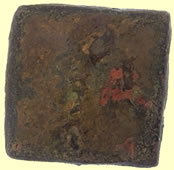 |
||
1205- 1210 John hammered silver short cross half penny - Cross pommee - Class iii Rev VLA*SIM - Moneyer Simon of Rhuddlan mint in Wales |
1604 James 1st Rose ryal gold coin weight | ||
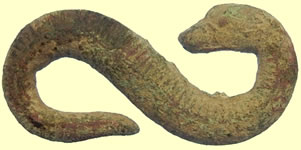 |
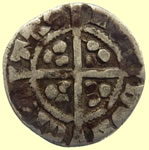 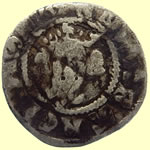 |
||
| 16thC Tudor S buckle | 1279 Edward 1st hammered silver penny Obv + EDWAR ANGL DNS HYB Rev CIVI/TAS/LON/DON - London mint |
||
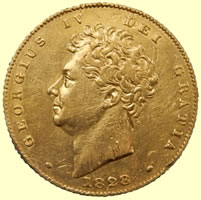 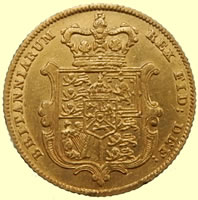 |
|||
1828 George IV milled gold half sovereign 19.1mm,3.98g |
|||
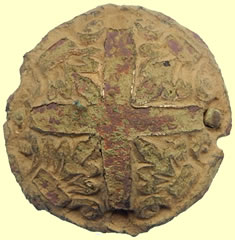 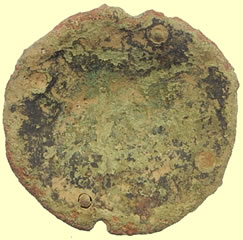 |
|||
Large medieval decorated and gilded shield boss or mount - 4 rivet fixings Obv - Cross with 4 Fleur de Lis in qtrs |
|||
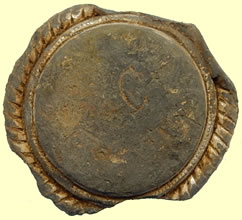 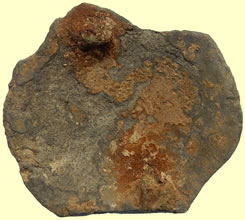 |
|||
| Georgian gilded lead carriage mount | |||
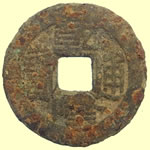 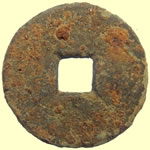 |
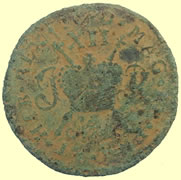 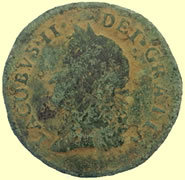 |
||
| 19thC Chinese cash coin | June 1670 James II gunmetal shilling (12 pence) | ||
|
|||
| A copper alloy pelta shaped mount dating from the Roman period. | |||
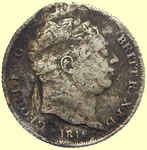  |
 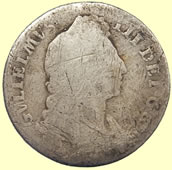 |
||
| 1816 George III milled silver sixpence | 1696 William III milled silver sixpence | ||
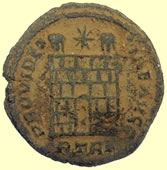 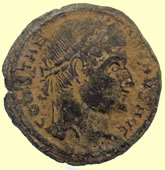 |
|||
Mint condition 4thC Roman bronze sent for ID Given the usual corrosion and edge-chipping we tend to see on almost all the Roman Æ you find, we have to assume both a long time in the plow-soil and/or harsh fertilizers and pesticides are to blame for the typically poor state of preservation to which we have become accustomed. This piece however, given its generally high state of preservation, patina and near total lack of edge-chipping makes me think this has only very recently been disturbed from a long-term site of deposition and may even be a piece from the top of a larger, so-far undiscovered group - or it might have been found elsewhere from the average, active farm fields you work - or both. Of course just about anyone can clearly read the CONSTANTINVS AVG obverse legend and tell it's Constantine I, "The Great", 307-337 AD. On the reverse, the PROVIDENTIAE AVGG legend framing the typical campgate of 6 layers with no door, two turrets, and a star above, and even the PTRE mint mark from the mint of Trier, is all perfectly clear as well. This places it in the final emission of centenionales with the PROVIDENTIAE campgate reverses, 327-8 AD. After this issue of campgates, the familiar two soldiers flanking one or two standards GLORIA EXERCITVS was introduced and became the most common and current reverse type for all issues of Centenionales for at least the next 15 years. The reference is: RIC VII 504 and this specific type is rated "C3" (extremely common) for frequency of appearance in major collections, mid 20th century. Mark |
|||
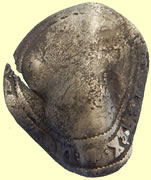 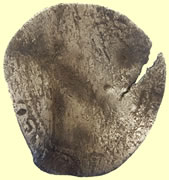 |
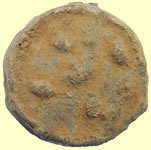 |
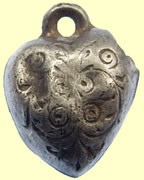 |
|
| 1613 - 15 James 1st hammered silver sixpence - Cinquefoil mint mark | 15thC lead token | Victorian silver locket | |
  |
|||
| Victorian lion mount | |||
 |
  |
||
| East Anglian regiment badge | Victorian 9 carat gold cane ring | ||
  |
 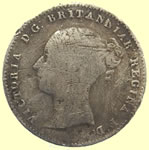 |
||
1204 John hammered silver short cross half penny - Class 5 Rev E.ON.S. - Moneyer Fv(o)lke of Bury St Edmunds mint |
1859 Victoria milled silver three pence | ||
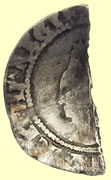 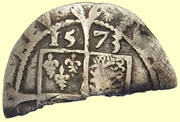 |
 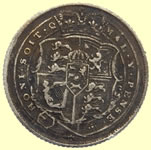 |
||
| 1573 Elizabeth 1st hammered silver sixpence | 1817 George III milled silver sixpence | ||
 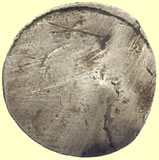 |
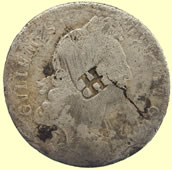  |
||
| 1580 Elizabeth 1st hammered silver three pence | Overstamped 17thC William III milled silver shilling GVLIEMVS error |
||
 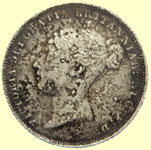 |
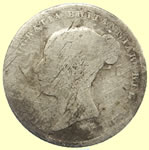 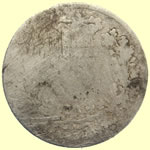 |
||
| 1841 Victoria milled silver sixpence | 1838 Victoria milled silver sixpence | ||
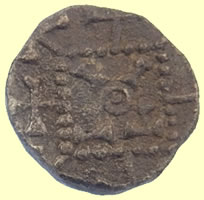 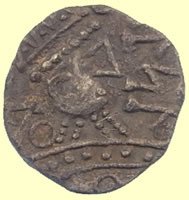 |
|||
c700 AD Saxon silver primary sceat sent to Fitzwilliam museum for ID and recording 1.16g, 12mm Many thanks for letting me know about this Series C2 sceat, which is EMC 2015.0066.
|
|||
BC looking Roman silver coin - cooking to remove crust - sent for provisional ID |
|||
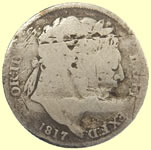 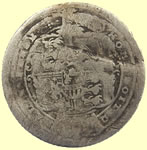 |
  |
||
| 1817 George III milled silver sixpence | 1889 Louis I Portuguese 100 reis milled silver coin | ||
  |
  |
||
| 1695 William III milled silver sixpence -Early harp large crown | 1634 Charles 1st hammered copper rose farthing | ||
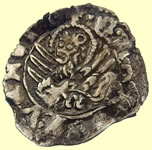 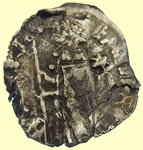 |
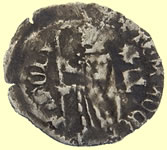 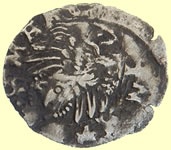 |
||
Italian States-Venice, Michele Steno as Doge (1400-1413), Soldino, Venice Mint |
Italian States-Venice, Antonio Venier as Doge (1382-1400), Soldino, Venice Mint |
||
Venetian Soldino legends and history During the early 15th and early 16th centuries the English economy experienced so serious a shortage of English-struck halfpennies that people began using foreign coinage to fill the gap. The coin they used was the Venetian soldino. The Venetians were notorious traders in the late medieval period with trade networks covering the Mediterranean and Europe. The Venetian fleet of galleys set out for England during May and stayed there until late August or early September, During these summer months soldini entered the English economy through trade with Venetian merchants and quickly became widespread across England. The soldino, meaning ‘little shilling’ became nicknamed the ‘galyhalpens’, or Galley-halfpence, after the ‘Galley-men’ who imported them. While the general population was enjoying these new exotic coins, the government was grappling with two major problems. The first was that the soldino was an illegally imported coin, and the second was that it weighed slightly less than an English halfpenny but mimicked it nonetheless. Soldini therefore became a particular source of irritation for the English government. During the early 15th century port-officials were charged with confiscating any soldini they came across and were later given the powers to forcibly search the galleys. Contemporary documents show large quantities of soldini being seized at London, Dover and Southampton. By the 1420s the English government eventually persuaded the Venetian senate to forbid the export of soldini, which effectively stemmed the flow of the coins into England. This success was short lived however, as large quantities of coins were imported once more by Venetian merchants in the early 16th century. Venetian soldini span the period c.1382-1526. The dates of these coins show that the majority entered England in two substantial incursions: the first 1400- c.1415 under Doge Michele Steno, and the second c.1501-21 under Doge Leonardo Loredan Type 1 Type 2 Type 3 The Doges Andrea Contarini 1368-1382 (Type 1) Italian States-Venice, Andrea Contarini as Doge (1368-1382), Soldino, 1369-1379, Second Type, First Issue, Venice Mint, Filippo Barbarigo (May 10, 1370-May 18, 1385) as Mintmaster for Silver
Italian States-Venice, Antonio Venier as Doge (1382-1400), Soldino, Venice Mint Italian States-Venice, Antonio Venier as Doge (1382-1400), Soldino, Venice Mint Italian States-Venice, Antonio Venier as Doge (1382-1400), Soldino, Venice Mint
Italian States-Venice, Michele Steno as Doge (1400-1413), Soldino, Venice Mint |
|||
 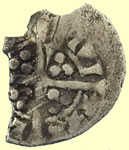 |
 |
 |
|
1285/6 Edward 1st hammered silver farthing - new issue inner circle both sides - Type 28 Oval flan Rev CIVI/TAS/LON/DON- London mint |
19thC Army volunteer button - BV | 16thC sword hanger with lower eye | |
 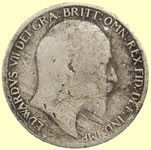 |
 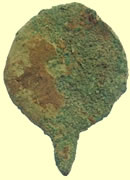 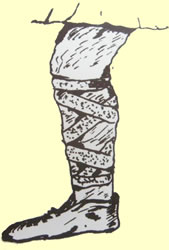 |
||
| 1903 Edward VII milled silver sixpence | c8thC Saxon gilded hooked fastener used on their leg bindings | ||
  |
  |
||
| 1554 mary hammered silver groat | 1500-1650 hooked mount | ||
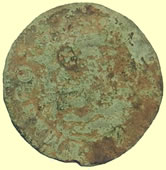 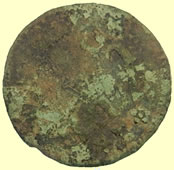 |
 |
 |
|
| 17th Dutch copper coin | 15thC lead token | Early medieval lead token | |
 |
 |
  |
|
| Georgian silver thimble | 1900 Generic merchant navy button | 1854 Victoria milled silver three pence | |
  |
  |
||
| Post medeival ela dbale seal - Port of Liverpool | 17thC George Nicholson hammered copper trade farthing - grocers, Thorpe le Soken Essex - not dated type | ||
 |
 |
|
|
| Georgian shoe buckle | 1914 On War Service “The issue of the badge originated by a very large number of men declaring that they were taken, to use their own words, for “shirkers and slackers” and taunted in the street for not wearing Khaki.” (Ministry of Munitions records at the PRO, sub-file MUN5/64/322/125). |
Bar with suspension loop - not sure of use Like a Celtic wode grinder but not that old |
|
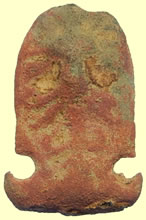  |
|||
Late Saxon stirrup strap mount Class A type 4 The central design contains a variety of symmetrical looping shapes. Each type 4 has a projectng 'nose' Ref David Williams |
|||
 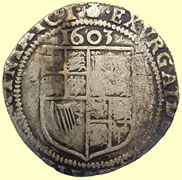 |
 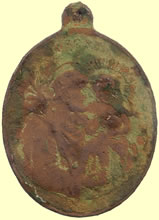 |
||
| 1603 James 1st hammered silver sixpence | Victorian St Christopher pendant | ||
2ndC Roman silver coin - needs 'cooking' to remove crust |
|||
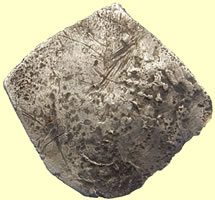 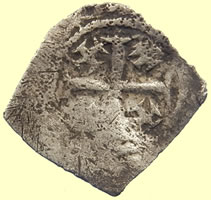 |
|||
1158 -1189 AD Henry II hammered silver penny ' Tealby' cross and crosslet type 1.14g, 19mm x 20mm In 1158 a monetary reform was introduced in England which was of sufficient importance for the contemporary chroniclers to record that 'a new money was made, which was the sole currency of the kingdom.' This coinage is notorious for its ugly appearance, bad craftsmanship and careless execution. It continued till 1180, and is named after a large hoard which was found at Tealby, Lincolnshire, in 1807
Many thanks for this very helpful information about the find, which I have recorded as EMC 2015.0073. |
|||
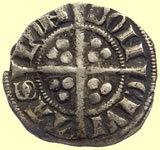 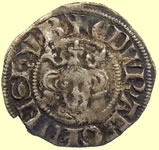 |
  |
||
1299-1300 Edward 1st hammered silver penny - Class 9 , Top tilted S - Closed C&E Obv +EDWAR ANGL DNS HYB Rev CIVI/TAS/LON/DON - London mint |
1369-1377 Edward III hammered silver penny - post treaty period, quatrefoil with pellet at centre of reverse cross Obv +EDWARDVS R**** NGLI Rev CIVI/TAS/EBO/RACI - York mint |
||
 |
 |
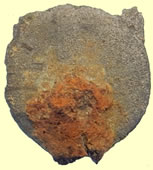 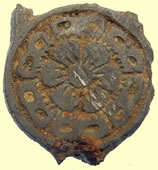 |
|
| 16thC Tudor clothing fastener | 19thC livery button | 16thC Tudor clothing fastener | |
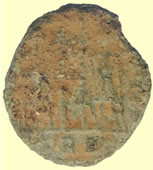  |
 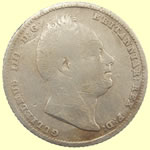 |
||
| Mid 4thC House of Constantine Roman bronze - twp soldiers standing type | 1834 William IV milled silver sixpence | ||
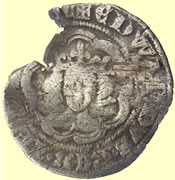 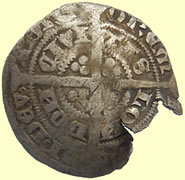 |
|||
1351- 1353 Edward III hammered silver half groat- Pre Treaty C, No cusps over crown- IM Cross 1- E&C's closed- N's reversed , wedge tail R Lombaric M in reverse legend +EDWARDVS o REX ****NC Rev ****/VI+DEVo/ADIV/OREM/ CIVI/TAS/LON/DON - London mint |
|||
 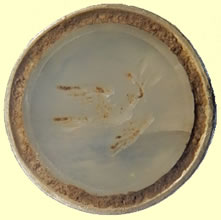 |
|||
| Georgian fob seal - Dove of peace flying right | |||
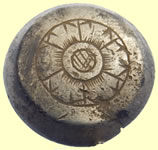 |
 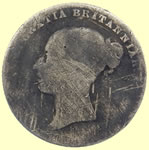 |
||
| 18thC Royal Navy silver button | 1867 Victoria milled silver sixpence | ||
  |
 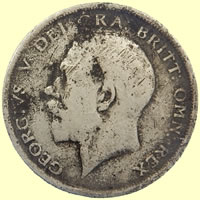 |
||
| 1816 George III milled silver sixpence | 1916 George V milled silver half crown (30 pence) | ||
 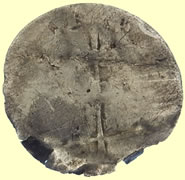 |
 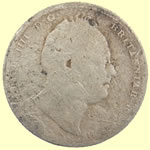 |
||
| 1554 Mary hammered silver groat | 1830 William III milled silver sixpence | ||
|
|||
Only our 2nd ever Henry 1st find and our first ever cut half penny of this King. This halfpenny has a voided cross type next to the fleury that is not in my reference books. 1100 AD Henry 1st hammered silver half penny - Quadrilateral on cross fleury type Henry I (c. 1068 – 1 December 1135), also known as Henry Beauclerc, was King of England from 1100 to 1135. Henry was the fourth son of William the Conqueror Sent to Fitzwilliam museum for ID and recording |
|||
 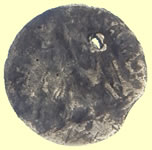 |
  |
||
1501-1521). Rev: LAVS TIBI SOLI (Thee Alone be Praised). Haloed figure of Christ holding a cross. Obv: LE LAV DVX S M V (Leonardo Lauredan, Doge. St Mark of Venice.) Doge kneeling before Saint Mark. |
1326 Edward III hammered silver penny Obv +ED*** S ***ANGLI Rev CIVI/TAS *** |
||
 |
 |
 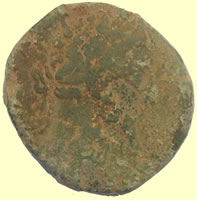 |
|
| 1500-1700 mount | 1500-1700 mount | 2ndC Roman bronze coin | |
 |
|||
